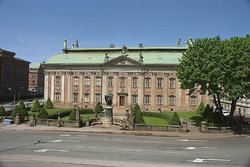Swedish nobility
|
|
The Swedish nobility (Adeln) was historically a privileged class in Sweden. Noble families and their descendants are still a part of Swedish society today, but do no longer retain any specific or granted privileges to speak of. The Swedish nobility is organized in to three classes according to a scheme introduced in 1561, where the classes are:
Swedish dukes (hertig) have always been royals and counted as such.

Following the elevation into nobility by the Swedish monarch, the key concept was that of introduction to ones peers at the House of Knights (Riddarhuset), which formerly was a chamber in the Riksdag of the Estates, the Swedish Parliament. After 1866 the House of Knights served as a official representation on the nobility regulated by the Swedish government, but the regulation has decreased in step with the privileges. Virtually all noble families are introduced (with the exception of some members of foreign nobility that, while having been naturalized to the royal court, never has been introduced), and their members are listed in a calendar published every three years.
| Contents |
Medieval nobility
The nobility in Sweden (and Finland) dates back to 1280 when it was agreed that magnates who could afford to contribute to the cavalry with a horse-soldier were to be exempted from tax - at least from ordinary taxes - as the clergy already had been. The archaic Swedish term for nobility, frälse, includes also the clergy while referring to their exemption from tax.
The background was that the old system of a leišangr fleet and a king on constant travels in the realm became outmoded and in need of replacement. The crown's court and castles were now to be financed through taxes on land.
Soon it was also agreed that the king should govern the realm in cooperation with a Privy Council (or Royal Council) where the bishops and the most distinguished among the magnates (i.e. the most prominent contributors to the army) participated. When troublesome decisions were necessary all of the frälse was summoned to diets.
The Swedish nobility had no hereditary fiefs. In case they were appointed to a castle of the crown's then their heirs couldn't claim their civil or military authority. The lands of the magnates who constituted the medieval nobility were their own and not "on lease" from a feudal king. If they by own means (including the suffering of the local peasantry) build a castle, and financed its troops, then the castle was theirs but the troops, of course, expected to serve as a part of the realm's army.
For extended periods the commander of Viborg at the border to Novgorod/Russia did in practice function as a margrave, keeping all the crown's incomes from the fief to use for the defense of the realm's eastern border. But despite the heavy German influence during the medieval age the elaborate German system with titles such as Lantgraf, Reichsgraf, Burggraf and Pfalzgraf was never applied.
Nobility after 1561

At the coronation of Eric XIV in 1561, nobility was first stated as formally hereditary, when the higher titles of Count (greve) and Baron (friherre) were created. The House of Knights was organized in 1626. The reasons for introduction were birth into an "ancient" noble family, or enoblement by the king. A great interest for genealogy followed.
The Lord High Chancellor, Axel Oxenstierna, was the architect of the Instrument of Government of 1634, which laid the foundation of modern Sweden. It secured that all government appointments had to be filled by candidates from the nobility, a move which helped to mobilize support of, rather than opposition against, a centralized national government.
Due to the many wars, the crown needed a means to reward officers, and since cash was not plentiful, enoblement and grants of land were used instead. During the 17th century, the number of the noble families grew by a factor of five. In less than a century, the nobility's share of Swedish land rose from 16% to over 60%, which led to considerably lower tax incomes. The "reductions" of 1655 and 1680 however brought back land to the crown.
Following the German example, all members of a noble family generally are titled. If the family is of the rank of Count or Baron, all members receive that title as well. Following the new Instrument of Government from 1809, a change was made towards the British system, so only the head of the family holds the status. There are also such families where all members are noble but only the head is a Count. But this rule applies only to nobiliations made after 1809, so the vast majority of noble families are still of the old type.
In contrast to the United Kingdom and the Benelux countries, no hereditary titles or honours have been granted since 1902, when explorer Sven Hedin was enobled (that dignity was hereditary, but he left no heirs). After 1975 there is even no legal right of enoblement. Deposed royal princes have been granted Luxembourgish or Belgian titles of nobility instead.
Privileges
The noble estate was never abolished in Sweden, but its privileged position has been weakened step by step since 1680. The nobility's political privileges were practically abolished by the reformation of the Riksdag of the Estates in 1866, and the last rights of precedence to certain governmental offices were removed in the 1920s. By then also the last taxation privileges had been abolished. Some minor privileges remained up until 2003, when the law concerning the privileges of the nobility was completely abolished.
The privileges of the nobility today are limited to protection of noble titles and certain elements and styles used in coats of arms: a helm with open visor, a coronet showing rank, and the use of supporters. Legal protection regarding names in Sweden does not make specific distinctions on the grounds of nobility.
See also
External links
- The House of Knights (http://www.riddarhuset.se/) - Official site
- Law on Privileges for the Nobility (1723) (http://wikisource.org/wiki/Ridderskapets_och_adelns_privilegier) - at Wikisource (in Swedish)
- Constitution for the House of Knights (1866) (http://wikisource.org/wiki/Riddarhusordning) - at Wikisource (in Swedish)
